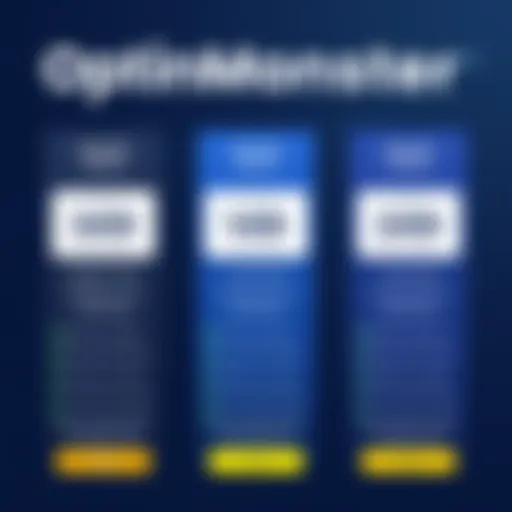Comprehensive Overview of Cloudbeds Hotel Management Software


Intro
Cloudbeds has emerged as a significant player in the hotel management software arena. It aims to empower hotel operators with a suite of tools that streamline operations and improve guest experiences. Understanding this software can aid decision-makers in optimizing their hospitality ventures. This overview will dissect the key features and functionalities of Cloudbeds, identify the target users, analyze pricing models, and delve into the potential return on investment for businesses.
Key Features and Functionalities
Comprehensive Overview
Cloudbeds offers a wide array of features tailored for hotel management. At its core, it includes property management systems that allow for seamless booking and check-in processes. The dashboard is user-friendly, providing operators with real-time data on room availability, pricing, and occupancy rates.
Another crucial aspect of Cloudbeds is its channel management feature, which enables integration with various online travel agencies (OTAs) such as Booking.com and Expedia. This ensures that hotel listings are consistently updated across platforms, reducing the risk of overbooking and maximizing revenue.
Additionally, Cloudbeds provides a customer relationship management (CRM) tool, allowing hoteliers to engage with guests effectively. This feature aids in personalized marketing efforts and enhances guest satisfaction by providing tailored experiences.
Target Users
The primary users of Cloudbeds software include:
- Small to Medium-sized Hotels: These establishments benefit most from the comprehensive and cost-effective solutions offered.
- Hostels and Vacation Rentals: They can utilize Cloudbeds for efficient booking management.
- Boutique Hotels: Unique properties can leverage customization options to enhance their brand experience.
In essence, the platform is versatile and caters to a wide range of hospitality businesses.
Pricing Models and Cost Analysis
Breakdown of Pricing Tiers
Cloudbeds follows a subscription-based model. The pricing is tiered, accommodating different sizes and types of properties. The basic plan generally includes core functionalities, while higher tiers unlock advanced features such as enhanced reporting and integration options. It is essential for businesses to evaluate their specific needs to choose the appropriate tier.
Additional Costs to Consider
While the initial pricing may seem attractive, there are additional considerations. These can include:
- Transaction Fees: Some payment gateways may impose fees per transaction.
- Training and Support: New users may need training sessions, which could incur additional charges.
- Customization Costs: Any bespoke features or integrations may also require extra investment.
Evaluating these potential costs is critical for an accurate budget.
"Hotel management software should not only meet current operational needs but also align with future growth strategies."
Understanding the detailed features and associated costs of Cloudbeds allows decision-makers to make informed choices on whether this software will meet their hotel management needs effectively. The subsequent sections will discuss user experiences and industry comparisons, further aiding in this evaluation.
Foreword to Cloudbeds Hotel Management Software
Cloudbeds is a crucial player in the hotel management software space. As hospitality evolves, operators face an increasing need for systems that can integrate various functionalities into a cohesive platform. Cloudbeds responds to this need effectively, assisting hotel managers in multiple ways.
The importance of adopting a robust management software like Cloudbeds cannot be understated. It offers a comprehensive approach to managing daily operations, from bookings and guest relations to revenue management. By streamlining these processes, hotels can focus more on enhancing guest experiences rather than getting bogged down in administrative tasks. This can lead to improved guest satisfaction and repeat business.
It's essential to consider the specific elements that Cloudbeds provides. The software’s Property Management System, for example, organizes all hotel operations seamlessly. The Channel Manager ensures that visibility across various platforms is maximized, reducing the chances of overbookings. This feature is especially vital given the variety of online travel agencies available today.
Another aspect to consider is the Booking Engine. This tool allows hotels to drive direct bookings, minimizing dependency on third-party channels. A crucial point for many operators is understanding how these features translate into measurable outcomes. Increased efficiency leads to better financial performance and a significant enhancement in guest relations through tailored experiences.
Decision-makers must also consider factors such as ease of implementation and training. The learning curve associated with new software can be steep, so comprehensive training and ongoing support are paramount.
"The ability to have all hotel operations integrated into one system cannot be underestimated in today’s fast-paced environment."
Key Features of Cloudbeds
The significance of the key features of Cloudbeds lies in their ability to provide a comprehensive solution for hotel management. These features unite various tools essential for streamlining operations, optimizing guest experiences, and enhancing revenue management. For hotel operators, understanding these aspects is critical for making informed decisions regarding their software needs.
Property Management System


The Property Management System (PMS) is central to Cloudbeds’ functionality. It allows hotel operators to manage room inventory efficiently, oversee bookings, and handle check-ins and check-outs with ease. This feature is essential for ensuring that operations run smoothly on a day-to-day basis. The intuitive interface helps staff streamline tasks, minimizing errors and enhancing operational accuracy. Important aspects include:
- Room Allocation: Automatically assigns rooms based on guest preferences and availability.
- Real-time Updates: Reflects changes instantly to avoid overbooking or confusion in reservations.
- Reporting: Generates reports to help management assess performance, occupancy rates, and guest feedback.
Channel Manager
A robust Channel Manager is crucial for effective distribution across various platforms. Cloudbeds equips users with tools to connect with multiple booking channels such as Expedia, Booking.com, and Airbnb. This functionality increases property visibility and can lead to higher bookings. It offers several notable advantages:
- Centralized Control: Users can manage rates and availability from a single dashboard.
- Automatic Updates: Ensures any changes made in the PMS are reflected across all channels.
- Performance Tracking: Provides insights on which channels perform best, aiding in strategic planning.
Booking Engine
The Cloudbeds Booking Engine optimizes the user experience for potential guests. This feature enables hoteliers to offer a direct booking option on their website, minimizing reliance on third-party platforms and associated commission fees. Key benefits include:
- Customization: Tailors booking pages to reflect property branding and aesthetics.
- Mobile Optimization: Ensures a seamless experience for users booking on mobile devices.
- Upselling Options: Allows hotels to promote ancillary services, enhancing revenue potential.
Revenue Management Tools
Effective revenue management is vital for maximizing profitability in the hospitality sector. Cloudbeds includes tools that provide insights into pricing strategies based on demand fluctuations. The key functionalities include:
- Dynamic Pricing: Adjusts room rates in real-time according to market conditions.
- Forecasting: Offers demand forecasting to anticipate busy periods and adjust strategies accordingly.
- Competitive Analysis: Analyzes competitor pricing to position offerings effectively within the market.
Guest Relationship Management
Cloudbeds emphasizes the importance of maintaining strong guest relations. The Guest Relationship Management (GRM) tools are geared towards enhancing the overall guest experience from initial booking to post-stay communication. Noteworthy features encompass:
- Personalization: Collects guest data to tailor services and communications.
- Feedback Integration: Enables easy collection and response to guest feedback, enhancing service offerings.
- Loyalty Programs: Facilitates the creation and management of loyalty programs to encourage repeat bookings.
The comprehensive array of Cloudbeds’ key features sets a strong foundation for effective hotel management, aligning operational efficiency with enhanced guest experiences.
Benefits of Using Cloudbeds
Cloudbeds offers various advantages that can significantly enhance hotel operations. Understanding these benefits is essential for decision-makers, such as hotel operators and owners, who look for efficient management solutions. This section explores how using Cloudbeds can lead to better operational performance, elevate guest satisfaction, increase revenue, and provide integration possibilities.
Improved Operational Efficiency
One of the most compelling benefits of Cloudbeds is its potential to improve operational efficiency. The software facilitates numerous tasks, from managing room inventory to processing bookings. By automating repetitive processes, staff can devote more time to guest interaction and service. Efficiency also comes from the software's intuitive interface, which reduces the learning curve for new users.
With features like real-time data synchronization across all platforms, hotel operators can avoid overbookings and streamline check-in/check-out processes. Consequently, this improves the overall workflow and minimizes manual errors. As a result, operational costs may be lowered, enabling more effective resource allocation.
Enhanced Guest Experience
Cloudbeds also seeks to enhance the guest experience through personalization and convenience. A modern booking engine allows guests to book rooms easily, while features like automated pre-arrival emails ensure that guests receive crucial information.
Moreover, the guest relationship management component allows the hotel to track previous stays, preferences, and feedback. This information can be utilized to tailor future stays, offering personalized services that create loyalty. A satisfied guest is likely to return, and word-of-mouth referrals can also increase, which is invaluable for brand reputation.
"A seamless guest experience leads to higher satisfaction scores and increases the likelihood of repeat business."
Increased Revenue Opportunities
Another critical advantage of Cloudbeds is its potential to increase revenue. By employing advanced revenue management tools, hotels can optimize pricing strategies based on demand, competition, and market trends. The channel manager feature ensures that room availability is consistent across multiple booking platforms, maximizing exposure.
Dynamic pricing can be implemented to adjust rates in real-time, further enhancing revenue. Identifying peak periods and adjusting offerings accordingly can help capture additional income. Automated tools make it easier for properties to implement these strategies effectively.
Integration with Third-party Applications
Cloudbeds supports integration with various third-party applications, such as payment processors, marketing tools, and guest experience platforms. This flexibility allows hotels to customize their tech stack according to specific needs. For instance, integrating with a marketing automation tool can enhance promotional strategies, while connecting to a payment processor can streamline the booking process.
Seamless integration minimizes silos and enables data to flow freely across all platforms, thus supporting better decision-making. This capability helps enterprise-level hotels manage complex operations efficiently while providing smaller establishments access to essential features.
In summary, the benefits of using Cloudbeds extend from improved operational efficiency to enhanced guest experiences, increased revenue opportunities, and integration capabilities with various applications. Decision-makers should carefully consider these aspects when evaluating hotel management solutions to ensure a better fit for their unique operational needs.


Pricing Structure of Cloudbeds
Understanding the Pricing Structure of Cloudbeds is essential for hotel operators and management teams assessing its viability for their establishments. The pricing model informs prospective users of both cost implications and potential return on investment, which is critical in today's competitive hospitality market. Knowing the subscription types and how they compare to competitors can significantly influence purchasing decisions. Here, we will delve into two main areas: the subscription models Cloudbeds offers and how its pricing holds up against competitors in the sector.
Subscription Models
Cloudbeds provides various subscription models to accommodate the diverse needs of its users. Generally, there are three primary tiers based on the size of the property and specific requirements:
- Basic Package: This entry-level model is aimed at smaller hotels or inns that require essential management features. It includes core functionalities like a property management system and some basic guest relationship tools.
- Standard Package: The mid-tier option is suitable for mid-size hotels that need advanced features. This includes additional channel management capabilities, in-depth reporting, and enhanced revenue management tools.
- Premium Package: Designed for larger properties or chains, this model offers all available features. It provides comprehensive integrations with third-party applications and priority support.
Each subscription level is designed to scale with the business, allowing hoteliers to choose a model that best meets their operational needs and budget constraints. Pricing might vary based on the number of rooms and added functionalities.
Cost Comparison with Competitors
When comparing Cloudbeds' pricing structure to that of its competitors, it becomes clear that value for money is a significant consideration. Cloudbeds often stands out due to the breadth of features included at each pricing level, making it potentially more cost-effective than similar software like Oracle Hospitality OPERA or Guestline.
- Comprehensive Features: Many competitors charge extra for features that are included in Cloudbeds' packages, such as the booking engine and channel management. This can lead to a higher overall cost for users choosing other solutions.
- Flexible Payment Options: Unlike some other platforms that require a lengthy contract, Cloudbeds often allows for flexible pricing arrangements, which can be appealing to new businesses unsure of their long-term hotel management software needs.
"The transparent pricing model of Cloudbeds makes it easier for hoteliers to budget and plan effectively."
Implementation Process of Cloudbeds
The implementation process of Cloudbeds is crucial for ensuring that hospitality businesses can derive maximum value from this software. A well-structured implementation not only helps in integrating the diverse functions of Cloudbeds but also enhances the overall user experience. A smooth implementation minimizes disruptions to daily operations and sets the stage for improved operational efficiency. Decision-makers must consider the specific elements and benefits associated with the implementation process to facilitate a seamless transition to Cloudbeds.
Initial Setup
In the initial setup phase, various steps are taken to configure Cloudbeds according to the unique requirements of each property. This includes defining room types, setting pricing strategies, and establishing policies for bookings and cancellations. To start, hotel operators need to import their existing data, such as guest information and room inventory, into the Cloudbeds platform. This ensures continuity and accuracy in operations from day one.
Cloudbeds offers a guided setup process, which simplifies this task. Users can follow step-by-step instructions, reducing the likelihood of error. Moreover, successful initial setup often involves engaging with Cloudbeds support staff. They can provide valuable insights and troubleshooting support during this stage.
Training and Support
Training is a pivotal element of the Cloudbeds implementation process. Effective training ensures that staff members are not only familiar with how to use the software but also understand its features and capabilities. Cloudbeds offers comprehensive training resources, including webinars and documentation, tailored to various user levels.
Support does not end after the initial training. Long-term access to customer support is essential. Hotels can utilize ongoing help via chat, email, or phone to resolve any issues that may arise. This ensures that staff can focus on servicing guests rather than struggling with their software.
"User training and continuous support are key to maximizing the benefits of Cloudbeds and improving guest experiences."
Ongoing Maintenance
After successful implementation, ongoing maintenance becomes necessary to keep the Cloudbeds system running efficiently. This includes regular updates to the software, which helps in fixing bugs and introducing new features. It is vital for property managers to stay informed about these updates to leverage new tools that could enhance their operations.
Additionally, ongoing maintenance involves monitoring how Cloudbeds is used in daily operations. By evaluating user feedback and identifying areas for improvement, hotel managers can optimize the software's use. Regular check-ins with the support team can also provide insights into best practices and emerging trends that could benefit hotel operations.
User Experience and Reviews
User experience and reviews are critical for understanding the overall effectiveness of Cloudbeds. They provide real-world insights into how the software performs in various environments. Positive user experiences often highlight the software's strengths and usability. On the other hand, constructive criticism can illuminate areas needing improvement. The insights gathered from user reviews can guide decision-makers in evaluating whether Cloudbeds aligns with their operational needs and guest expectations.
Positive Feedback from Users
Many users praise Cloudbeds for its intuitive interface and ease of use. This simplicity enables hotel staff to navigate the platform without extensive training. Users often report a smoother check-in process, improved communication with guests, and enhanced booking functionalities. Cloudbeds offers an integrated approach that connects various hotel operations efficiently, leading to increased productivity.
Additionally, customer support is frequently mentioned as a highlight. User testimonials often reflect satisfaction with the responsiveness and helpfulness of the support team. Access to robust training resources further enhances the overall experience for new users. They appreciate step-by-step guides and video tutorials that simplify onboarding. In summary, positive feedback centers on usability, customer support, and comprehensive training resources.
Challenges and Limitations
Despite the many favorable reviews, some users have shared challenges they encountered while using Cloudbeds. A common concern involves occasional system glitches or downtimes, which can disrupt hotel operations. When these issues arise, they may frustrate staff and lead to complications in guest service.
Moreover, a minority of users feel that the pricing model may not be entirely transparent. They suggest that additional fees are sometimes not well-advertised, which can lead to unexpected expenses. Users have also expressed a desire for more advanced customizability in specific features. While Cloudbeds covers a wide range of functionalities, some suggest that niche requirements could be better addressed. These challenges are important to consider when evaluating Cloudbeds as a hotel management solution.


"User feedback plays a crucial role in shaping software development and features, especially in a dynamic industry such as hospitality."
Comparison with Other Hotel Management Solutions
Understanding the landscape of hotel management solutions is essential for decision-makers in the hospitality industry. The right software can drastically affect operational efficiency and guest satisfaction. Cloudbeds is a notable option, but how does it stack up against similar tools? This section delves into the competitive landscape and offers insights that can guide informed choices.
Competitor Analysis
In the hotel management software arena, various competitors vie for attention. Each offers unique advantages and challenges. Key players include StayNTouch, RoomRaccoon, and eZee FrontDesk. Each of these systems has its strengths and target audience, impacting the selection process for hotel operators.
- StayNTouch caters primarily to boutique hotels and offers a mobile-first solution that enhances guest interactions. It streamlines check-in and check-out processes dramatically.
- RoomRaccoon automates several essential tasks, like pricing, refunds, and reviews. It focuses on small to medium-sized businesses looking for budget-friendly options.
- eZee FrontDesk is comprehensive and serves both small hotels and enterprise-level operations, featuring multi-language support and connectivity to various booking channels.
Understanding the niche that each competitor fills can help operators assess which alignment fits their needs best. Not all hotels need the same features, and knowing what competitors offer allows for tailored decision-making based on unique operational requirements.
Feature Comparison
A detailed examination of features is paramount. Cloudbeds includes many functionalities, but comparing these features with those of other solutions provides a clearer view of the value proposition.
- Property Management System (PMS): Cloudbeds offers a robust PMS that integrates guest history and bookings. Competitors like StayNTouch focus heavily on mobile capabilities, while eZee FrontDesk has a more traditional approach.
- Booking Engine: Cloudbeds has a seamless booking engine that integrates directly into the website. In comparison, RoomRaccoon provides multi-channel capabilities, which perhaps is appealing for those who deal with various platforms.
- Channel Manager: Cloudbeds’ channel manager connects with numerous OTAs, whereas eZee FrontDesk has a strong foundation in localized channels.
In this digital age, evaluating the specific features that match the operational goals of a hotel is critical. Decision-makers must prioritize their operational needs against the capabilities provided by each solution.
The right software choice is a blend of understanding both the features offered and the specific operational needs of the business.
The feature comparison not only uncovers what software can best serve a hotel's requirements but also signifies the importance of aligned expectations. Cloudbeds shines in its integration capabilities but may not be the top choice for hotels needing specialized features found in competing products.
Ultimately, this thorough comparison of Cloudbeds and its competitors ensures that hotel operators can make an informed choice, empowering them to select a management solution that truly fits their needs.
Future Trends in Hotel Management Software
The landscape of hotel management software is experiencing rapid transformation, driven by advancements in technology and the evolving needs of guests. Understanding these trends is essential for decision-makers and IT professionals in the hospitality industry. The right insights can help enhance operational strategies and elevate guest experiences, ultimately affecting the bottom line. This section will delve into two critical components: emerging technologies and changing guest expectations.
Emerging Technologies
Technological advancements are shaping the future of hotel management software. Solutions that leverage artificial intelligence (AI), machine learning, and automation are becoming prevalent. These technologies can perform tasks that once required manual intervention, allowing hotels to operate more efficiently.
- AI and Chatbots: Hotels are implementing AI-driven chatbots for customer service inquiries. This technology allows instant responses, helping to manage reservation questions or providing quick information about services available.
- Data Analytics: Using data analytics, hotel operators can make informed decisions based on historical data. These insights can lead to better pricing strategies, targeted marketing campaigns, and understanding guest preferences.
- Mobile Integration: With guests increasingly using smartphones, mobile functionality in hotel management systems is vital. This includes mobile check-ins, service requests, and digital room keys, enhancing convenience for both guests and hotel staff.
"Innovation must be at the forefront for hotels to remain competitive in a rapidly changing market."
These emerging technologies not only streamline operations but also provide a competitive edge in a crowded marketplace. They allow hotels to respond promptly to market demands and enhance the overall guest experience.
Changing Guest Expectations
The expectations of guests today are markedly different compared to previous generations. As millennials and Gen Z become the primary demographics traveling, their preferences are influencing hotel management strategies. Understanding these expectations is critical for hoteliers aiming to attract and retain customers.
- Personalization: Guests expect tailored experiences. This includes personalized recommendations for services based on past preferences and behaviors. Software that can analyze guest data and provide relevant offers is essential.
- Seamless Connectivity: Modern travelers prioritize connectivity. Hotels need to offer robust Wi-Fi, mobile apps for room service and reservations, and integrations with popular travel platforms.
- Sustainability: An increasing number of guests are concerned about sustainability. Hotels that adopt eco-friendly practices and transparently communicate these efforts attract environmentally conscious travelers.
End and Recommendations
In the realm of hotel management software, the role of conclusion and recommendations cannot be understated. It serves as a crucial final analysis for readers who seek to implement efficient systems that enhance operations and improve guest experiences. This section synthesizes the insights discussed throughout the article, focusing on the potential of Cloudbeds and its suitability for various hotel operators.
Making the right choice in software solutions is vital for decision-makers. Consideration of specific features, benefits, and implementation processes discussed earlier allows for a well-rounded perspective. By reflecting on these aspects, stakeholders can align their operational goals with the capabilities of Cloudbeds, ensuring a more informed selection process.
Final Thoughts on Cloudbeds
Cloudbeds stands out as an intuitive hotel management software designed to meet the challenges of modern hospitality. Its robust property management system, strong channel management features, and effective revenue management tools create a versatile toolkit for hotels aiming to maximize efficiency. The emphasis on guest experience and integration with third-party applications further amplifies its appeal.
As the landscape of hospitality continues to evolve, Cloudbeds' commitment to adaptation ensures that it remains relevant. By streamlining day-to-day operations, hotels can focus more on delivering exceptional service to their guests.
Who Should Consider Cloudbeds?
Cloudbeds is ideally suited for a broad spectrum of hotel operators. Specifically, the following entities should consider this software:
- Independent hotels seeking comprehensive management tools without extensive overhead.
- Boutique hotels that require customization to enhance guest experiences.
- Hostels and vacation rentals looking for an integrated solution for bookings and guest management.
- Small to medium-sized chains aiming to standardize operations across multiple locations.
Decision-makers in these areas should evaluate their unique operational needs and growth objectives to determine if Cloudbeds aligns with their vision for the future.















